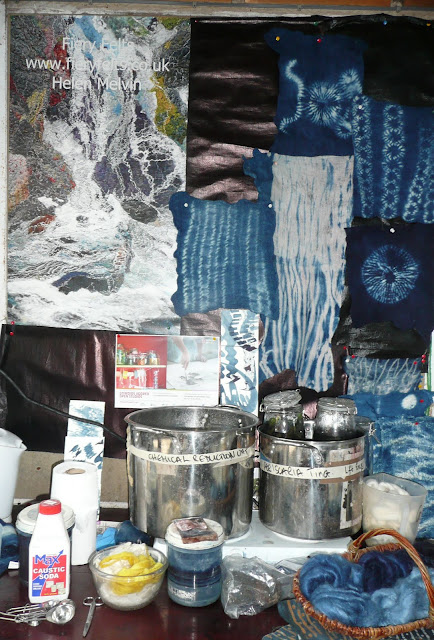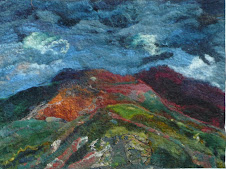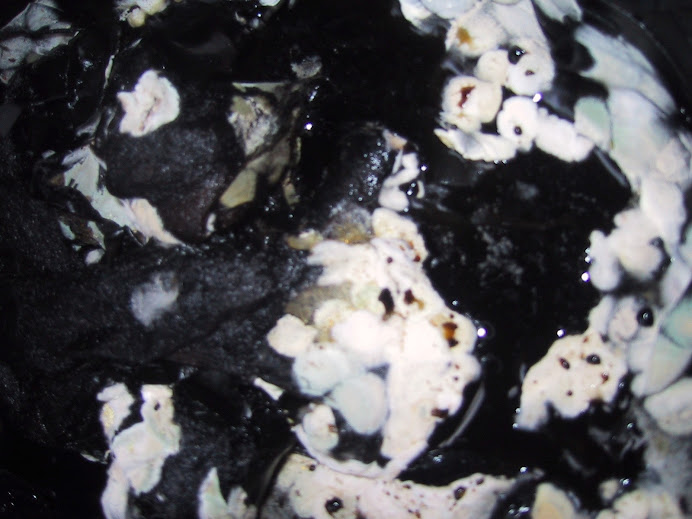At last time to write a blog. Well that is not strictly true what I really mean time to do something and write a blog about it. Somehow Christmas and a frozen world had blocked all my creativity
This is what the dye garden looked like after heavy snow and -10degees C . Most of the UK and now half of he US look like this not to mention many European countries but I like to have a memory of what is a very unusual event for us.
I waved off the family yesterday and immediately fell down into the dumps, the post Christmas blues hit me right between the eyes. This required emergency action so after a token stripping the beds and dumping sheets into washing machine I began to think. Although we have had a thaw here my studio still has all the water turned off as I have one burst pipe and all the dye pots and also my mordant pots are all frozen up. However I did manage to pull out some mordanted carded mohair. Aha! This has a history, Years and years ago our local bargain store that sold bin ends had some of this . As spinners we were very snooty about it as it spun nothing like spinning mohair from fabulous high quality mohair fleece. . However it is just the thing for Pluckyfluffs clouds of mohair yarn. page 139 of Intertwined by Lexi Boeger aka Pluckyfluff ISBN 13-978-1-159253-374-9 Here carding fabulous mohair results in too heavy a result so rather than light clouds I had lumps. Now I didn't have this mohair but a friend of a friend had bought masses and being a hoarder there it was in a huge sack in her loft which she now wanted to clear out so this is what I dyed in preparation for a lovely exciting spinning session. January is such an ideal month for sitting warm and cosy and spinning.
So quietly while DH was out with the dog and no one could see I crept into the kitchen and dyed carefully on the kitchen table. ( I feel guilty only because I have a studio, an office and mostly a summer house for my own use not to mention two spinning wheels, a drum carder and related baskets in the sitting too) but actually DH only laughed at my sneaked in little dyeing corner)
I mixed up lac, cochineal, logwood, logwood and fustic and Jazz (an Earthues dye that gives a reddy purple) If you are going to do this don't forget to wear a mask and gloves and never use for dyeing something you might later want for cooking
I put some cling film onto an old baking tray more to contain the dye than for any other reason
I poured some of the dye in and then covered it with cling film and pressed the dyes into the rest of the mohair.
Then I added a silk cap to mop up the excess dye. Although my mordanted pot was full of them I could only free two and even these had to be defrosted in my studio microwave
Then I microwaved the lot for 5 minutes ( in my studio microwave )
You know it is ready when the cling film is crinkled and sucked in slightly. Ideally leave the dyes overnight to set at this point -which is what I always tell my students but what the hell! Laws are made to be broken and I wanted a result. So I rinsed and spun in the washing machine and put the stuff to dry by the wood burner. By this time even outside the camera flashed when photographing it so the colour are not quite as dark as they in real life but although the cochineal gave me a little too much pink I was pleased with the resulting colour.
Tonight I hope to sit and spin . In Pluckyfluffs instructions she says to card mohair interspersing it with some sparkly stuff and colour and then to ply with sparkly yarn. Hmm! I am not to keen on sparkle bur a yarn I had plied with some sparkly stuff went in a flash at Trefriw Christmas market so maybe I need to be a bit more relaxed about it. Besides I have some bought at a stall when I did Lexi's workshop on Bristol in March
I am still reading Respect the Spindle. This not a new book but one I came across recently so new to me. I found this a most inspiring book and it really got be going on spindle spinning again so much so I sat on the sofa for two nights spinning watching television and spinning by rolling down my thigh. This meant I was sitting slightly twisted and the following morning I could hardly move and then I developed sciatica . Two months on it is still giving me a bit of a problem . This is hardly an advert for the book but in fact it is the best spindle book I have ever read and I loved it . Especially the story of how Abby learnt spinning a child in the Andes and of leaning over the Inca ruins to spindle and see who amongst her friends who could spin the longest yarn without breaking. It was usually her she says who had to hurtle down the mountains side to get her spindle. The book is full of photos of spindles with beautifully spun cops of wool and she tells you how to do all sort so different spindling as well as having projects in the back. Now I have a thorough dislike (normally ) of books which are full of projects but these are in fact quite gorgeous and I have started to spin (cautiously) for the neck warmer .
The second book I have had on my shelves for a while and used the freedom of having time for a concentrated read to get into it although I found it hard going.
The Root of Wild Madder by Brian Murphy ISBN-13 978-0-9432-6421-1
This is a book about Brian Murphy's love affair with Persian carpets
I nearly threw it in the bin following a snooty comment about western natural dyers being hobbyists on the level of someone milk churning at a country fair and I struggled too as he writes rather too much about politics and history of Iran and Afghanistan . Slowly however I began to see how he was trying to set Persian carpets into context but he also went off on a mild spiritual journey inspired by a mediaeval poet and Sufism so he could find a carpet that had meaning for him. He describes the best carpets as a form of poetry. However and infuriatingly he had very few photos of the carpets he talked about even the ones he bought. Verdict on the book? Interesting yes, would I recommend it to a friend -hmm- not really it seemed to fall between a lot of stools for me. It told me nothing new about natural dyes, not enough about carpets and too much about politics and history.
I can't believe I forgot to post!
-
I've been spinning an awful lot the past few weeks. I have spun about 1300
yards according to counting yardage on my niddy noddy. It's not totally
accu...
3 days ago













































































